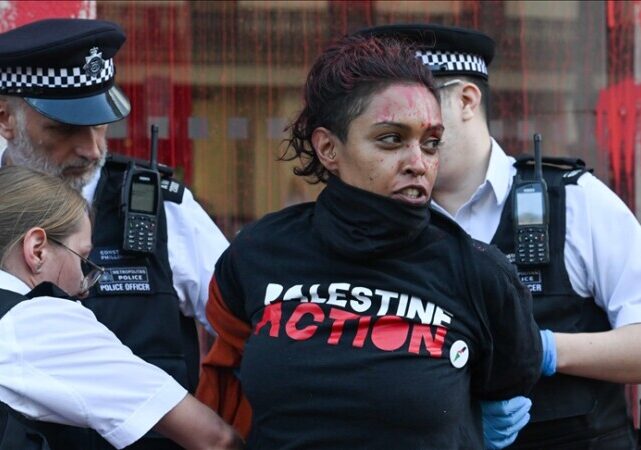O
n September 23, 2022, Ukrainian President Volodymyr Zelenskyy stated that Ukrainian forces were able to shot down a total of eight Iranian drones over the skies of Ukraine.
“Today, the Russian army used Iranian drones for attacking the Dnipropetrovsk region and Odesa,” Zelenskyy stated in a late-night video address.
In response to the Iranian collaboration with Russia, Ukraine decided to revoke the accreditation of the Iranian ambassador in Kyiv, in addition to decreasing the number of diplomatic personnel of the Iranian Embassy significantly.
The United States has accused Iran of providing Russia with Iranian-made drones to use in Ukraine.
Much earlier, on July 11, 2022, U.S. national security adviser Jake Sullivan had pointed out the “severe cost that Russia has had to endure on the battlefield as it tries to grind out territory in the east.” Sullivan shared with reporters that the U.S. had information indicating that the “Iranian government is preparing to provide Russia with up to several hundred UAVs including weapons-capable UAVs.”
One month later, a senior U.S. administration official, who spoke on condition of anonymity to Reuters, claimed Russia had faced “numerous failures” with Iranian-made drones.
Several pictures and videos showing Iranian drones being used in Ukraine were posted and shared on social media.
On October 17, the mayor of Kyiv, Vitali Klitschko, reported a drone attack in the capital’s district of Shevchenkivskyi in a Telegram post. According to Klitschko, 28 drones flew in the direction of Kyiv and a total of five explosions were heard. He also published a picture of the wreckage caused by one of the kamikaze drones used in the attack.
The drone strike killed four people, including a woman who was six months pregnant and her partner. They died under the rubble of a house “which was hit by a Russian terrorist drone,” Klitschko stated.
Ukraine invited UN experts to inspect debris from what it says are Iranian-made drones used by Russia to attack Ukrainian targets, according to a letter seen by Reuters and the Voice of America (VOP).
In the letter sent by Ukraine’s ambassador to the UN Sergiy Kyslytsya, Ukraine claimed that Russia received prohibited items from Iran including Mohajer- and Shahed-series unmanned aerial vehicle (UAV).
The letter referred to Iran’s violation of UN Security Council Resolution 2231 that endorsed the 2015 Iran nuclear deal. Kyslytsya noted that both the Mohajer and Shahed drones are manufactured by Quds Aviation, which is subject to an international asset freeze under the resolution, VOP added.
On October 19, the United States, France, and the United Kingdom held a closed-door UN Security Council meeting to discuss Russia’s use of Iranian-made drones in Ukraine.
“Initial analysis suggests that UAVs were transferred from Iran to Russia in open violation of provisions of UN Security Council Resolution 2231. As was outlined during today’s meeting, there is ample evidence that Russia is using Iranian-made UAVs in cruel and deliberate attacks against the people of Ukraine,” said the United Nations Spokesperson Nate Evans.
On October 20, both the United Kingdom and the European Union agreed to impose sanctions against three Iranian individuals and one Iranian entity said to participate in developing and transferring drones to Russia.
In September, the United States also imposed sanctions on an air transportation service provider for its involvement in the shipment of Iranian UAVs to Russia, in addition to three companies and one individual involved in the research, development, production, and procurement of components for Iranian UAVs, according the U.S. Department of the Treasury. In November, the department imposed further sanctions for the same reasons.
Iranian and Russian Statements
At least for the duration of October, Iran did not accept the accusations leveled by Western countries, and denied supplying Russia with any kind of weapons.
Spokesman for the Iranian Ministry of Foreign Affairs Nasser Kanaani, stated during a weekly press conference that “Iran has not exported any weapons to any of the war parties.” Kanaani claimed such news was published for political reasons and mainly fueled by Western sources.
In addition, during a UN Security Council media stakeout, ambassador Amir Saeid Iravani, permanent representative of the Islamic Republic of Iran to the United Nations, stated, “The Islamic Republic of Iran has taken a clear and consistent position on the situation in Ukraine which has been pronounced since the start of the conflict.”
Iravani also stressed that “Iran has consistently advocated for peace and the immediate end to the conflict in Ukraine.”
However, Iranian Foreign Minister Hossein Amirabdollahian spoke at the beginning of November about Iran delivering drones to Russia but before the start of the war and in a small number.
Recommended
“We have provided Russia with a limited amount of drones months before the war in Ukraine, and we agreed with the Foreign Minister of Ukraine that if they have any documents that Russia has used Iranian drones in Ukraine, they should provide them to us,” Amirabdollahian told reporters.
He also renewed Iran’s call to both sides of the conflict to stop the war and start negotiations. He accused European countries of launching a campaign against Iran by accusing it of arming Russia in the war against Ukraine.
Ukrainian President Zelenskyy rejected this explanation by Iran. He claimed that Ukraine shoots down at least ten Iranian drones every day. “Only during one day, yesterday, 11 Shahed drones were destroyed. We know for sure that Iranian instructors taught Russian terrorists how to use drones,” Zelenskyy stated.
As for Russia, it has also denied employing Iranian combat drones in Ukraine. According to Reuters, Kremlin Spokesperson Dmitry Peskov said the Kremlin did not have any information about their use. “Russian equipment with Russian nomenclature is used. All further questions should be directed to the Defense Ministry,” Peskov added.
Moreover, following the closed-door UN Security Council meeting on Russia’s use of Iranian-made drones, Russia’s deputy UN ambassador, Dmitry Polyanskiy, spoke and denied all accusations. “Today we observed another round of the disinformation campaign from the Security Council by the Western delegations. They try to distract the attention of the International Community from their defective engagement in the conflict in Ukraine,” he stated.
Polyanskiy insisted and stressed that the UAVs are made in Russia. He also threatened to reassess collaboration with the UN.
Polyanskiy called on Secretary-General of the United Nations António Guterres and his staff to “abstain from engaging in any illegitimate investigation. Otherwise, we will have to reassess our collaboration with them, which is hardly in anyone’s interests.”
Iran’s Allies Own Iranian-Made Drones
With Iran’s advancement in drone production, Iran’s allies also began using drones, especially in Lebanon and Yemen.
On July 2, Hezbollah sent “three unarmed UAVs of various sizes” toward the contested Karish offshore gas field. Israel claimed that “one of the drones was downed by an F-16 fighter jet and the other two by Barak eight missiles launched from the Sa’ar 5-class corvette INS Eilat.”
Yemeni Houthis have also used explosive-laden drones in several places. In September 2019, Houthis attacked Saudi Arabia with ten drones targeting Saudi Aramco oil facilities in Abqaiq and Khurais.
In January 2022, Houthis launched several drone and missile attacks on the United Arab Emirates, according to Al Jazeera. The attacks targeted a fuel tank and an under-construction extension of Abu Dhabi International Airport.
In February 2022, the Houthis targeted Abha International and King Abdullah bin Abdulaziz Airport in Saudi Arabia. The Saudi-led coalition announced that its air defenses intercepted a drone, wounding 12 people at Abha airport with shrapnel. It also announced the destruction of the drone launched by the Houthis against the King Abdullah Airport in Jizan.
Many consider the development of Iran’s drone program and the possession of drones by its allies as a real threat and danger to the region.
Seth J. Frantzman, a Jewish-American analyst and author of Drone Wars has claimed that the Iranian and Iranian-backed attacks are a clear threat to regional stability. “Iran has increasingly used drones in the region to attack countries; and also trafficked drones to proxy and allied groups and even shipped them to Russia, Venezuela, Ethiopia and other places; including arming Hamas, the Houthis, Hashd al-Shaabi in Iraq and groups in Syria, and Hezbollah,” Frantzman wrote.
Only time could tell if Iranian drones in Ukraine will have an impact on the course of war. The supply of Iranian drones to Russia will only complicate its relationship with the West especially vis-à-vis its nuclear deal.





